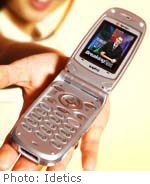
NEW YORK (Fortune Magazine) -
One of the more fascinating mutations in recent years, perhaps not on the level of Michael Jackson but fascinating nonetheless, is the evolution of mobile phones into multimedia communications devices.
Mobile phones used to be, well, phones that were mobile. Now they're capable of being used for browsing the web, checking e-mail, sending and receiving instant messages, taking digital photos, storing calendar and contact information, recording voice memos, and playing music and games. The Israelis have even used mobile phones as detonation devices for bombs, although that's a function not recommended for most consumers.
With the advent of third-generation (3G) phone systems worldwide, mobile handsets – notice how "phone" takes on less importance – can even be used as automated wallets for purchasing things, as remote controls for home appliances, and as television receivers for those who can't get enough TV at home.
I've been watching TV on my cell phone for a few weeks, courtesy of a new service called MobiTV. It's the first service to deliver live, streaming television to mobile handsets, in this case, to a Sanyo SPC-5500 phone connected under the Sprint PCS Vision service. Unique to Sprint at this point, MobiTV plans to offer its streaming TV to other carriers later this year.
A sign of the times, the first thing I saw on MobiTV after launching the service was a commercial for male erectile dysfunction. The technology of cell phone television may be new, but television is the same old crap.
I hasten to add that I haven't been watching TV on my cell phone as I drive. The world is dangerous enough with morons talking on the phone while trying to park their Hummers or shifting lanes at 70 miles per hour. No, I restrict my telephone television to sentient situations, like sitting in the airport lounge before a recent flight to Las Vegas. People in the lounge didn't look at me as if I was a nutcase, but then again, this WAS a flight to Vegas.
Here's the deal: If you have a Java-enabled Sprint phone, like the Sanyo I've been using, it takes just a few clicks and $10 a month – on top of the $15 a month Sprint charges for its Vision service, which is on top of whatever you pay for your monthly phone service – to sign up for MobiTV and download the application to the phone.

Then it's simply a matter of using the phone menu to select MobiTV and to choose one of 14 channels, including MSNBC, CNBC, ABC News, the Learning Channel, the Discovery Channel, and an assortment of cartoons and music video channels.
The hard part is answering the question, Why?
The genial folks at Idetics, a Berkeley, Calif., company that provides the MobiTV service, have a plausible answer: Americans love TV and watch it every chance they get, they say. Now, with MobiTV, they don't have to be near a TV.
Apparently quite a few people love TV enough to watch what turns out to be a pitiful excuse for live TV on a dinky screen at a frame rate of one frame per second. The experience is basically like watching a tiny, blurry slide show, with lousy sound.
Yet MobiTV, according to Sprint, is one of the most popular and lucrative services on its data services network. There are usage spikes whenever something big is happening in the news, but on normal days there's a steady demand for music and cartoons. Early adopters of the MobiTV service appear to be young and male, according to the company. The hip-hop music channel is quite popular.
| CNN/Money: Personal Tech
|

|
|
|
|
The MobiTV folks acknowledge the slide-show nature of the service, noting that most people are used to seeing regular TV at 30 frames per second. They say the technology will improve over time as cell phones get more powerful processors, as mobile-phone screen technology improves, and as the company makes more efficient use of the available bandwidth to increase the frame rate. New phones with improved processing power will be available later this year, they say.
MobiTV is also exploring the addition of new channels, to go beyond the 14 available today. Sports is a logical attraction; loyalty to a team might transcend the limitations of the technology. MobiTV is thinking about adding premium channels, perhaps even including movie channels.
But that's another problem: Mobile handset batteries today don't last long enough, in steady use, to make it all the way through a movie. And my guess is that if customers have the time to watch a movie all the way through, they're probably going to plop down in front of a big-screen TV or make their way to the theater.
As it stands today, MobiTV's service is a novelty. The choppy, postage-stamp video, frequent interruptions, and limited content leave a lot to be desired. I can't recommend it, except to people so addicted to TV that they'll watch anything, anywhere.
But MobiTV is also one of those important technologies that gives us a glimpse of the future. It's going to get better. Yes, someday we'll be able to watch live, streaming, television-quality television on mobile handsets. That's kind of scary, isn't it?

|


